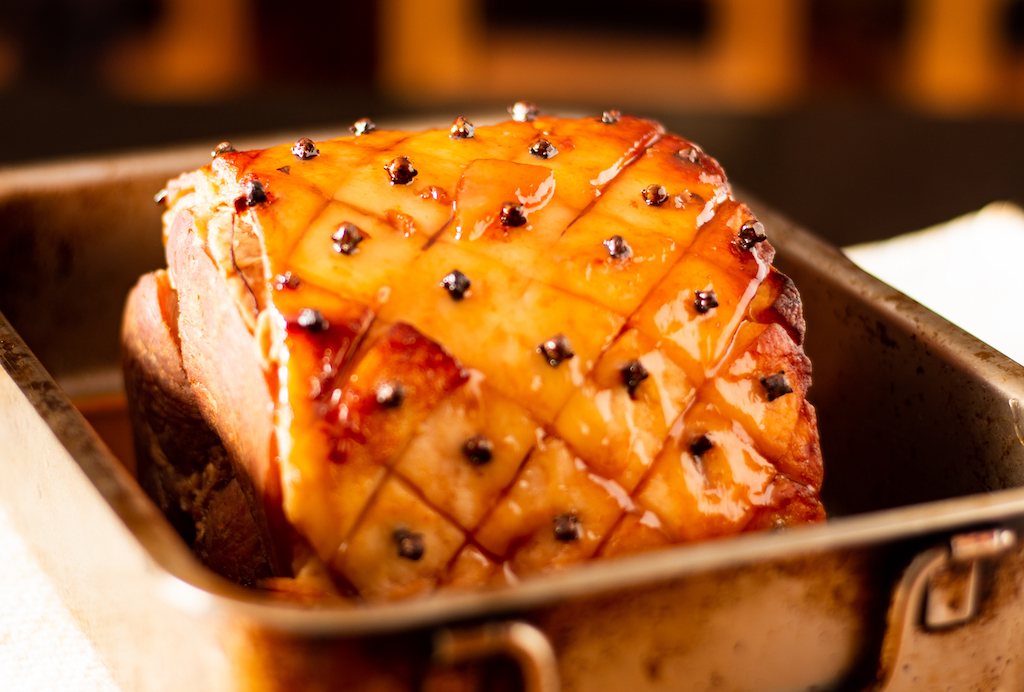The etymology of ham is truly confusing, and it is not helped by trans-Atlantic variations in use. Put simply, a hind leg of a pig is a leg of pork. If that leg is brined, then it becomes gammon. If you cook a gammon, you end up with ham. But if the gammon is served hot from the oven and cut thickly as a main protein in a meal, then it is still called gammon. Let it go cold and slice it thinly, then we are back in ham territory. In the US, the uncooked meat is called a ham, and the word ‘gammon’ never arises. So, in the UK, you can ‘make’ a ham, but in the US, you can only really buy one. I don’t know why it is that in their effort to simplify language by removing all the vowels, the Americans seem to make everything else so laboriously difficult to understand.
Regarding the origin of ham, Larousse proudly proclaims:
“The salting and smoking of pork to produce ham is of French origin.”
… and goes on to explain that it was the Gauls who perfected ham making, and they that would often eat it at the end of a meal to induce thirst. The Roman senator Cato the Elder wrote about salted hams in 160BC, and it is understood that Cato’s hams were coming from Gaul.
But, there is additional evidence that the Romans also had access to ham by trading with China. History indicates that the Chinese were curing the back end of pigs in 4,000BC, which basically kicks the Gallic invention claim straight into the long grass.
America came late to the ham party. Christopher Columbus took eight Spanish pigs to the New World, but it was actually a small herd of 13 pigs belonging to Hernando de Soto that became the origin of the entire US pork industry. Landing in Florida in 1539, de Soto soon had 700 pigs on his hands, and from there you can trace the whole history of the American love affair with bacon.
In the UK, we eat ham all the time, but for families cooking an entire ham for the table, this tends to be a Christmas thing. For the past few years I have been making sure I have a ham on the go from Christmas Eve until New Year’s Day, and the recipe I favour is that of Gordon Ramsay.

Honey-glazed ham Gordon Ramsay
Ingredients
- To cook the ham:
- 3kg unsmoked boneless gammon joint
- 4 medium carrots, peeled and roughly chopped
- 1 leek, roughly chopped
- 1 onion, peeled and roughly chopped
- 1 tsp black peppercorns, lightly crushed
- 1 tsp coriander seeds, lightly crushed
- 2 cinnamon sticks, broken in half
- 2 bay leaves
- 1 handful of cloves
- For the glaze:
- 100g demerara sugar
- 50ml Madeira
- 25ml sherry vinegar
- 125g honey
Instructions
Put the gammon in a large saucepan and pour on enough cold water to cover. Add the carrots, leek, onion, peppercorns, coriander seeds, cinnamon sticks and bay leaves. Bring to the boil, turn down to a simmer and cook for 3 hours, topping up with more boiling water if necessary. Skim off the froth and any impurities that rise to the surface from time to time. If cooking in advance, let the ham cool in the stock overnight. Otherwise, allow it to cool a little, then remove from the pan. Strain the stock (you can save for this for soup etc, but you will have gallons of it, and it will sit in the freezer for a year).
To make the glaze, put the sugar, Madeira, sherry vinegar, and honey into a pan and stir over a low heat. Bring to the boil, lower the heat and simmer for 3–4 minutes until you have a glossy dark syrup. Do not leave unattended, as it will easily boil over.
Preheat the oven to 170°C.
Lift the ham into a roasting tin. Snip and remove the strings and then cut away the skin from the ham, leaving behind an even layer of fat. Lightly score the fat all over in a criss-cross, diamond pattern, taking care not to cut into the meat. Stud the centre of each diamond with a clove. Pour half of the glaze over the ham and roast for 15 minutes.
Pour on the rest of the glaze and return to the oven for another 25–35 minutes until the ham is golden brown, basting with the pan juices frequently. It also helps to turn the pan as you baste to ensure that the ham colours evenly.
Remove from the oven and allow to rest for 15 minutes before carving. Continue to baste as the meat cools – the cooling glaze in the pan will get gradually stickier until you get a fully golden ham with a stunning, sweet honey surface.




 (171 votes, average: 3.61 out of 5)
(171 votes, average: 3.61 out of 5)


1 Comment
Spiced Gammon Cooked in Cider – the Chef Mimi Blog
06/11/2020 at 12:02 pm[…] Then I found this, from the blog The Nosey Chef: […]